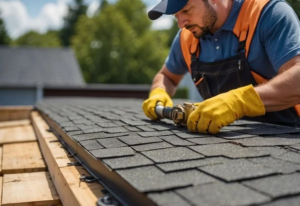The roof is the main barrier that protects a building from the elements. Its construction and materials can be varied to suit the needs of each site and its occupants.
Whereas there were few roofing options a few decades ago, homeowners can choose from various styles and colors today. This article will give a brief introduction to some of these. Click the https://www.ellingsonroofing.com to learn more.

When roofing a new home or revamping an existing one, choosing the right material is essential. It’s not just about cost or durability, it’s also about what kind of look and feel you want to create. Some materials are heavier than others and may require a different framing style, while some might not be suitable for certain climates.
Fibre cement roof sheets are great for rural areas and domestic builds due to their longevity, robustness and wide range of colours to suit most building styles. They’re extremely sustainable and offer some of the longest warranties available, ensuring they will last well beyond your lifetime!
Slate tiles are a popular choice for many homeowners due to their classic appearance and long lifespan. They’re a bit more expensive than other roofing materials but they add real value to your property and really make your home stand out.
Concrete tiles are another alternative to slate, with a similar lifespan and plenty of profiles to match up with your home’s design. They’re heavier than other roofing materials though and can cause damage to your roof if not supported adequately.
Rubber is a reasonably priced alternative to other roofing materials, offering the durability of slate and asphalt shingles at a much lower price. It’s also waterproof and can be made to look like other roofing materials to give you a seamless finish.
A more durable roofing option is metal, with steel or aluminium shingles or shakes being the most popular. These can be fabricated to look very similar to traditional asphalt shingles, wooden shakes or even slate. Metal roofs can last 30 to 50 years and are very versatile.
Membrane roofing is an effective water barrier that uses durable ethylene propylene diene monomer (EPDM) or polyvinyl chloride (PVC). It’s often used on low-sloped or flat areas of the roof, such as around chimney stacks and vents. It can also be a good alternative to other roofing materials for sheds and outbuildings. It’s a great choice for those who don’t want the extra maintenance and expense of regular tile or shingle replacement.
Installation
The roof is an integral part of any structure and protects the building interior from rain, snow, sunlight, wind and extremes of temperature. Roofs can be constructed in a wide variety of forms, including flat, pitched, vaulted, domed or in combinations, depending on technical, economic or aesthetic considerations.
When installing a new roof or re-roofing, there are many aspects of the process that must be carefully considered. Proper ventilation removes moisture from the attic, preventing damage to the insulation and wood framing, and helps regulate the interior temperature. Ventilation can be achieved through ridge vents, gable vents, or attic fans. Chimneys and flashing (the material that seals around chimneys and where roofing planes meet) should be properly sealed to prevent leaks.
During the re-roofing process, it is important to keep open communication with the contractor to ensure that all questions and concerns are addressed in a timely manner. When choosing a contractor, it is recommended to look for one who is credentialed by the manufacturer of your chosen roofing system. A quality contractor will have local references, a proven track record, an active certificate of insurance for liability and workers’ compensation, and be up to date with all industry and local codes. After installation, a final inspection should be conducted to verify that the work meets all industry standards and manufacturer specifications. A thorough site cleanup should also be performed to make sure that all nails and debris are removed from the property.
Maintenance
A roof is one of a building’s most critical elements. It protects against rain, snow, sunlight and extreme temperatures. It’s important to inspect a roof regularly, especially after weather events. This will prevent small problems from escalating to major issues that could cost thousands of dollars.
A standard roof maintenance checklist is a good place to start when developing a maintenance program. The checklist should be tailored to each type of roof, taking into consideration conditions specific to that area and the typical weather patterns experienced in that region.
The most common maintenance items include cleaning debris from the roof and making sure that drain lines are unobstructed. This will allow the roof to be free of water that might damage shingles or other roofing materials. Chimneys should be cleaned of a soot-like substance known as creosote, and all vents and skylights should be inspected for signs of leakage or other problems. Replacing or fixing flashing – the thin material installed to direct water away from chimneys, dormers and places where roof planes meet – can also help prevent leaks.
It’s also a good idea to check the caulking around roof penetrations and perimeters on a regular basis, repairing cracking or openings as necessary. A caulking failure may allow water to seep into the roof and cause damage. Adding a new layer of caulk can often extend the life of a roof. Other maintenance tasks include trimming tree branches to ensure that they don’t overhang the roof and removing moss and algae as needed. In addition, the gutters should be inspected and cleaned on a regular basis to avoid blockages that could cause the roof to delaminate.